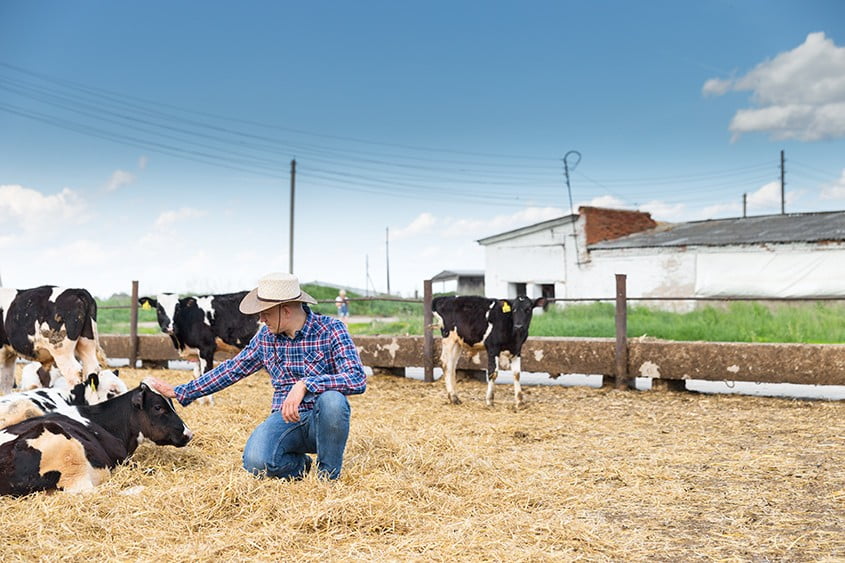
Tips for Feeding Your Livestock
Managing your feed is a combination of factors: formulating and choosing the correct blend of nutrients for your stock, dispensing it in the correct amounts, and making sure that it doesn’t spoil before distribution.
Creating your stock blend
For cows and sheep
Each form of livestock requires a different feed to survive. Cattle, sheep, and similar animals that make up the bulk of what people keep on their properties have a complex digestive system that requires different elements combining and going through four interwoven stomachs to provide the energy for survival.
These animals are called ‘ruminants’, and they are mostly suited to pasture feeding with supplementary feed. However, not all farms can sustain pasture feeding on a large scale, and even those that can will have to store feed for emergencies or during certain periods of the year.
Hay can be great during dry summers, or if you’ve got a lot of pregnant cattle, just remember to only buy good quality hay, as otherwise, it’s a risk for disease. Cows are also notorious for turning up their noses at cheap and nasty stuff, so it’ll save you money in the long term to not be wasting every third shipment.
For horses
Most horses, by comparison, are often fed with specific dietary requirements in mind. They’re much more similar to humans in that they require mostly protein, carbs, fats, and water, but these are usually bought in bulk amounts of cereals, proteins, and bulking elements such as sugarbeet to round it out.
Oats and barley are the two main cereals that you’ll see given to horses, with a much more varied series of proteins such as beans (soya being a major one), linseed, or milk pellets. As horses are usually a specialty animal with a lot of fine tuning behind them, they’re also supplemented with a range of specific ingredients for health issues (which often plague horses at the best of times) and training.
As a note, it’s important that after reading this that you don’t make any sweeping changes immediately to your livestock feed. Due to the digestive process being so slow and complicated, most livestock don’t take kindly to sudden changes; introduce any differences over a couple of weeks at a minimum, gradually changing them or letting them spend a little bit of time grazing in different circumstances instead.
How to store your feed
The other big side of feeding is in the storage. Keeping anything designed for consumption for a long period of time can be tough, especially under farm conditions. Without adequate storage and supervision, feed can go bad, providing a salient risk to the health of your livestock. Even if you catch it before feeding it to them, you’ll not only have to replace it, but replace it fast, meaning that you might miss out on good deals or bulk buying.
Straight away, you should always have a separate, designated area for feed that’s separated from the animals through a sturdy door such as one from the ARD Doors range, as the two biggest problems for your feed are going to be your livestock themselves, as well as rats.
Pests
Rats can get almost anywhere that isn’t secured, and will devastate your food crops. What’s worse, the tiny critters can get into the bottoms of packs, meaning that you might not even notice them nibbling away for ages. A sturdily constructed storage facility, such as a Titan Tidy Storage Locker, would be a great option for keeping sneaky pests at bay.
The other issue is the possibility of one of your herd barreling into the storage shed and gorging themselves. This won’t just lead to problems with your feed supplies, it’ll endanger the health of the animal. Cows in particular are liable to suffer from grain poisoning if they haven’t been acclimatised to it correctly, and won’t stop themselves wolfing it down even to the point of sickness.
A simple latch door isn’t enough, as a particularly cunning horse (or sometimes cow) has been known to use its lips to press a door lever down, gaining access to their own personal buffet. Grab yourself a padlock, and keep it on when you’ve left the area.
As well as this, you should keep feed in lidded bins. Preferably, you’ll be sticking to metal, but plastic ones can do if they’re designed for the task and sturdy enough to withstand a few hits. Keep in mind that an extremely determined rat pack can and will chew their way into one, despite your best efforts, over a period of time. However, if you keep an extremely good eye on them, regular wheelie bins can be a cost effective method of storage.
Preventing your feed from spoiling
Another issue you’ll run into is your feed simply spoiling over time. Keep it in areas with little moisture, as it’s otherwise likely that it will grow mouldy and unusable with excessive dampness.
ARD Roller Doors are a pretty safe bet when it comes to safe storage, and are designed with the Aussie climate in mind, so they don’t trap excessive heat or moisture in the air.
Keeping your feed safe from fires
Another issue that isn’t usually addressed is the possibility of fire. Feed is extremely susceptible to flame, and without common fire safety precautions, it can be a huge liability waiting to happen. Read up on your state fire codes, and make sure there’s no big fire risks waiting to happen. This can be as innocuous as harsh sunlight reflecting off of a metallic bin, so be prepared!
Keeping your feed safely stored
Investing in a strategy to keep your feed safe from the elements, as well as animals, will benefit you financially in the long run. Equipping your property with a proper feed storage facility will prevent any disasters from happening, and keep your animals well-fed and happy.

